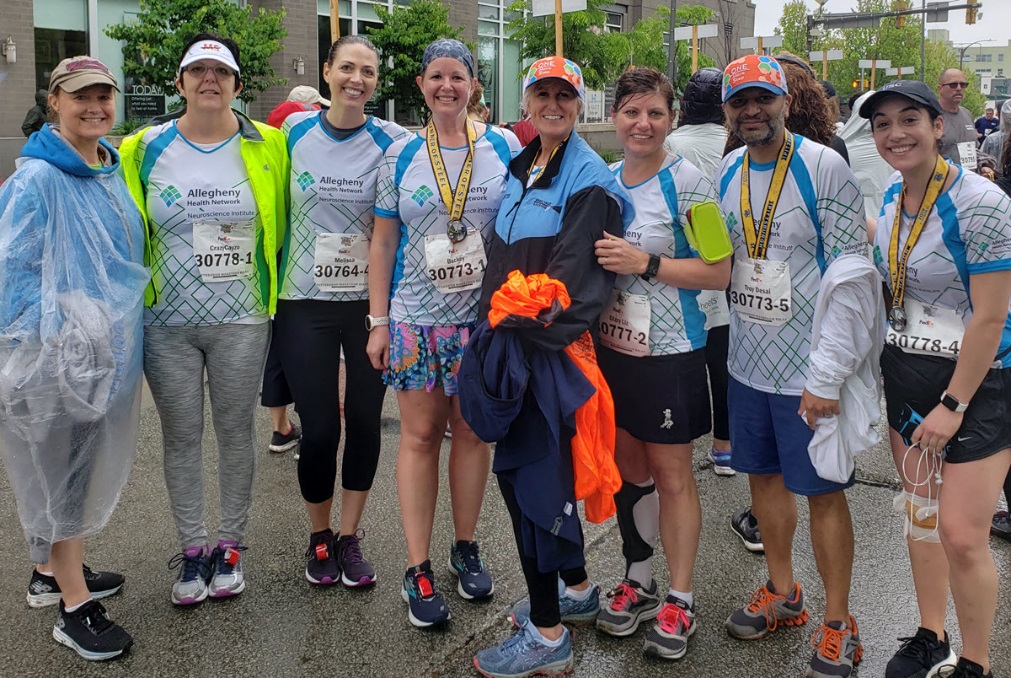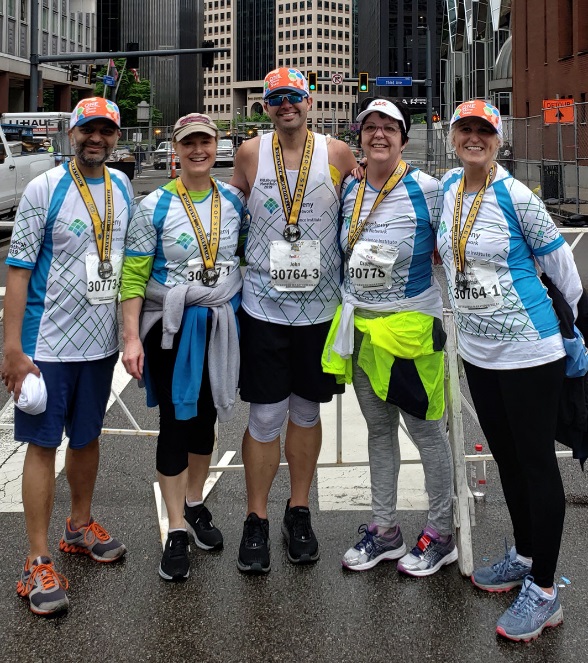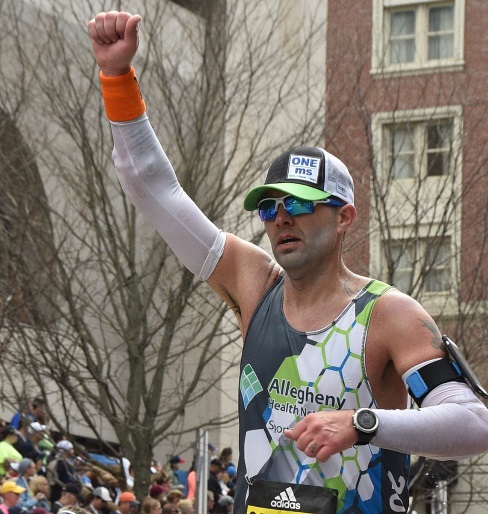In May 2019, 20 people dubbed “Team AHN Against MS” participated in relay teams to run the Pittsburgh Marathon. The group included individuals living with multiple sclerosis (MS), as well as physicians, nurses, and staff from Allegheny Health Network (AHN), and family members.
Finishing a marathon starts with a commitment to that first step of training. Similarly, the origins of this inspiring group can be traced back to the “one more step” commitment of team member John Platt, an adaptive athlete with MS.
“I never met a run I didn’t love,” Platt says. “Even the bad ones have made me better.”
As a runner and as a catalyst for improving MS awareness and empowerment for people living with the disease, Platt follows what he calls “John’s Rules” — and so will this article:

A few participants of Team AHN Against MS, left to right: Beth Stebbins, physical therapist; Carol Chieffe, RN; Melissa Frank; Beckey Powell; Mary Fetter, MS research study coordinator; Lizanne Boni; Dr. Troy Desai; Sarah Dakroub, RN
MS is a progressive, potentially disabling autoimmune disease where the immune system, which normally fights off infection, attacks the central nervous system (brain and spinal cord).
Troy Desai, MD — Platt’s neurologist…and Team AHN Against MS teammate — describes MS with an analogy. “Think of an electrical wire,” he says. “The axon, or nerve fiber, is like the copper, sending signals back and forth. Then there’s the myelin, which helps signals travel faster and protects the nerve — like rubber insulation around an electrical wire. With MS, the immune system damages that insulation, exposing or even transecting the nerve, which can disrupt the signals.”
The cause of MS is unknown, there is no cure, and until 1993 there was no effective long-term treatment. As late as 2005, only two classes of treatment, or Disease Modifying Therapies (DMTs), existed. Now, Dr. Desai says there are more than a dozen drugs which work via different mechanisms, and “progress is only speeding up.“
Platt believes anyone with MS should consider a DMT. “Without being on one, I wouldn’t be the runner I am,” he says. “If you’re trying to read a book, you don’t sit in the middle of a four-way intersection — you need to get to a place where your MS goes still and quiet. We live in a world where we’re blessed with solutions to help get you there.”
Dr. Desai emphasizes that a DMT can reduce or even stop further damage to the nervous system. “As a result, patients on DMTs are less likely to have new MRI lesions, relapses, and a gradual progression of disease. DMTs may even slow loss of brain cells,” he says. “However, the limitation is that they do not repair damage that has happened. Therefore, starting a DMT early is the best strategy.”
MS is sometimes called a “snowflake disease” because it manifests differently from person to person. Platt’s symptoms include tremors, an eye twitch, numbness, brain fog, fatigue and vision impairment. He also manages Uthoff’s Phenomenon — a temporary worsening of symptoms due to an increase in temperature. Specifically, as his core body temperature rises, he starts to lose vision altogether.
Running long distances…tends to raise body temperature. For marathons, Platt has run with a guide. He also combats the problem by applying ice to his neck and arms at aid stations. On a warm day, this becomes an endless cycle: run, lose vision, apply ice, run, lose vision, apply ice, run….
“MS is chronic and progressive.” he says. “So, I became progressively chronic.”
That mindset helped inspire the formation of Team AHN Against MS. The team concept is apt, as Dr. Desai points out, because it takes a team to treat MS: neurologist, physical therapist, nurses, speech therapist, psychiatrist, urologist, and other specialties.
Platt calls Dr. Desai “the driving force behind Team AHN Against MS.” But Dr. Desai says until recently he wasn’t even a runner. “In high school, one of our tests was to run a mile — I skipped the last lap,” he admits. He began running with Platt and other patients as a way to build trust.
“I can never completely understand what they go through,” Dr. Desai says. “But hopefully this helps show them that I’m on their team.”
Platt adds that, “The really cool thing about doctors is that they took an oath to preserve life. They have your best interest at heart, so if you let your guard down and trust a little bit, you start to find solutions.”

Left to right at the Pittsburgh Marathon: Dr. Troy Desai; Beth Stebbins, physical therapist; John Platt; Carol Chieffe, RN; Mary Fetter, MS research study coordinator. John ran three legs of the marathon relay: his own, and then two more with teammates who wanted company on their run!
On September 6, 2005, Platt was diagnosed with MS — one of approximately 1 million Americans now living with MS. At first, he says he didn’t have hope. Seeing a piece of MS literature predicting he would need an assistive device to walk, he says he soon “became that self-fulfilling prophecy.” He used a cane for seven years, and had a wheelchair in his garage for a future he thought was inevitable.
To get from that condition to running marathons is an example of another of “John’s Rules”: reframe, reframe, reframe.
“Everyone in their lifetime will face adversity,” he says. “It’s what you do with it that can make it one hell of a story.”
He then tells me about Gordy Ainsleigh, who completed an annual 100-mile horse race through vicious terrain — without a horse — in 1974. Traversing the route by foot in just under 24 hours, Ainsleigh helped give birth to the ultramarathon trail running events that now attract thousands of participants.
But on that first run, Ainsleigh tells people that 40 miles in, he realized it was “impossible” to finish. The temperature was 107 degrees, his legs were giving out, and he couldn’t focus his eyes on the dirt road. As bad as it was, the thought of quitting was worse. So, he decided to take “one more step.” Then one more. That reframe — focusing on a commitment and effort that was possible — helped him achieve the larger goal that seemed impossible.
Similarly, “one more step” has become a mantra for Platt in his own life and in his efforts to help others.
“You might be afraid,” he says. “But my motivation is to get people to take one more step out the door or toward their start line — wherever that start line might be.”
Platt’s “one more step” transformation began in 2013, eight years after he was diagnosed. He had lost a friend with MS due to heart complications and wanted to inspire his daughters to persevere — so he got on a treadmill. He struggled just to walk a mile — but returned to it again the next day.
“When MS flares up, there are days I count getting out of bed and brushing my teeth as one more step,” he explains. “You take the win when you can, but you take one more step, and string that out over days, and weeks, and years. That’s the journey from walking with a cane to running a marathon. That’s where the magic is — one more step.”
By 2014, “one more step” had inspired the goal of walking the length of 52 marathons in 52 weeks to raise awareness for MS. As of 2019, Platt has run eight marathons and six half-marathons. He has also completed the 35-mile Rachel Carson Trail Challenge, which includes treacherous slopes.
The journey has not been without setbacks. After his first Boston Marathon, he “picked up” a pelvic fracture — he didn’t feel when it happened due to body numbness. For close to two years, he rehabilitated with a High Performance Team at AHN under the guidance of Frank Velasquez, Jr., athletic trainer (ATC), strength and conditioning specialist (CSCS), and director of AHN Sports Performance and Physical Therapy.
Describing Velasquez as his “Mr. Miyagi“ (the teacher in the Karate Kid movies), and noting that “I never want to be complacent,” Platt says that as the rehab transitioned to performance training, they even induced a flare-up of his symptoms to better prepare him.
“It was about making John comfortable being uncomfortable,” Velasquez explains, adding that he considers Platt a “high-performing athlete” at this point. “John has proven a lot — most importantly that this disease doesn’t define him,” he says. “We have worked with a few MS runners now, but it’s not the norm.”
While working with Velasquez, Platt met former AHN physical therapist and longtime runner, Lauren Wentz. He calls her an “enabler” — a good thing in the context of “John’s Rules.”
“I know the word enabler has a bad connotation,” he says. “But here’s the thing: MS is disabling. You need to surround yourself with people who push you and enable you to do more. Lauren pushes herself to the limits, and she pushes me, too.”
Competing in the mobility-impaired division due to his leg numbness and spasticity, Platt had Wentz as his running guide in the 2017 and 2019 Boston Marathons. Adaptive athletes start first at this event, and when he and Wentz ran in 2017 they were in third place through the first 5k. “We were going way faster than I should have been running,” he says. “But she was having so much fun, and I was having so much fun….”
The experience with Platt helped inspire Wentz, who has a doctorate degree in physical therapy, to go back to school and earn a second graduate degree in Adapted Physical Activity. With AHN donating training and recovery services and Highmark as her main financial sponsor, Wentz is also participating in the 2019 MS Run the U.S., an annual 19-segment relay spanning 3,260 miles to raise funds and awareness for MS. Her 167-mile segment is near Pittsburgh.
“She’ll have some people keeping her company,“ says Velasquez. “I’m going to run day four with her, and John will pop in and out on different days. It’s an honor to be part of it and an honor that she trusts us to guide her — she’s doing something pretty phenomenal.“
Phenomenal — and, by Platt’s definition, enabling. “Who willingly signs up to run 167 miles in a week?” he asks affectionately. “Oh, and by the way, you need to raise at least $10,000 for MS as well! Lauren does that.”
Platt says that his success in no way negates the challenges of living with MS, including those that come with having an “invisible illness.”
“You can look good and still be a train wreck inside, because it’s neurological,” he points out.
Speaking of challenges…on February 1, 2019, Platt underwent cardiac ablation — a procedure in which catheters are inserted through a vein or artery in the groin and threaded to the heart. Using extreme heat, the goal is to scar heart tissue in a way that can help prevent arrhythmia, including atrial fibrillation.
“They burnt my heart for five hours,” Platt says. “So I reserve the right to call it a surgery.”
Medically, this didn’t interfere with plans to run his next marathon in April. But feeling a little unsure of himself, he decided to set four goals: run the marathon and run it well; not tax his heart more than necessary; finish in under six hours to qualify for the 2020 Boston Marathon; and run his fastest time ever.
“I hit the first three,” he says. “And that’s a victory. I believe you should fail every day. It doesn’t mean you’re a failure. It means you’re trying.”

Platt, just 400 yards from completing the 2017 Boston Marathon, where he placed ninth in his division. The “One MS” on his hat refers not just to the disease, but also to the magic of “One More Step.”
“For as much as I didn’t have hope when I was diagnosed,” says Platt, “I have all the hope in the world now.”
He also has influence. In addition to his inspiring runs and fundraising, he sits as founding chairman of the Pennsylvania Government Relations Advisory Committee for the National MS Society, and acts as a Peer Reviewer for the MS Research Program under the Congressionally Directed Medical Research Program.
“I sit alongside top neurologists and molecular biologists, ultimately critiquing and voting on MS research proposals,” he says. “I can do that because I’m the leading expert on my MS.” Reinforcing the point that MS manifests differently for everyone, he adds: “If you have MS, you’re the leading expert on your MS, too.”
His participation in discussions on MS research makes him confident that in his lifetime, there will be treatment that can stop the progression of MS. He hopes that in his daughters’ lifetimes there will be a full cure.
Platt tells me that the first time he ran a half-marathon, his dog didn’t greet him at the door, his wife was teaching, and his kids were at school. “There were no balloons at the finish line, and I woke up the next day and still had MS,“ he says. “And, in that sense, there are no balloons, because, technically, MS has no finish line.”
And “just ice cream”?
“That comes from my girls,” Platt says. “When they were younger, they always wanted to get ice cream, and because I’m a good dad, I would tell them no. Each time, they came back with two words: ’Why not?’ They’re right. Why not ice cream? Why not put a man on the moon? Why not take one more step?”
There is a balance to Platt’s message — he’s hopeful and positive, but honest about the challenges of living with MS…and living, period.
“Life is not supposed to be easy; it’s supposed to be lived. Take one more step, and then help others take one more step, too,” he says. Acknowledging the depression that can accompany MS and many other diseases, he adds: “Through the darkness, you may not see me or others, but we’re here. Those living with MS are never alone.”